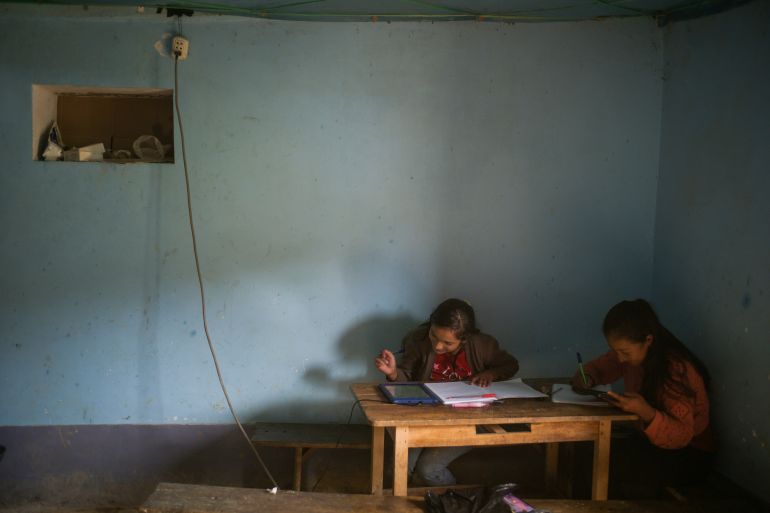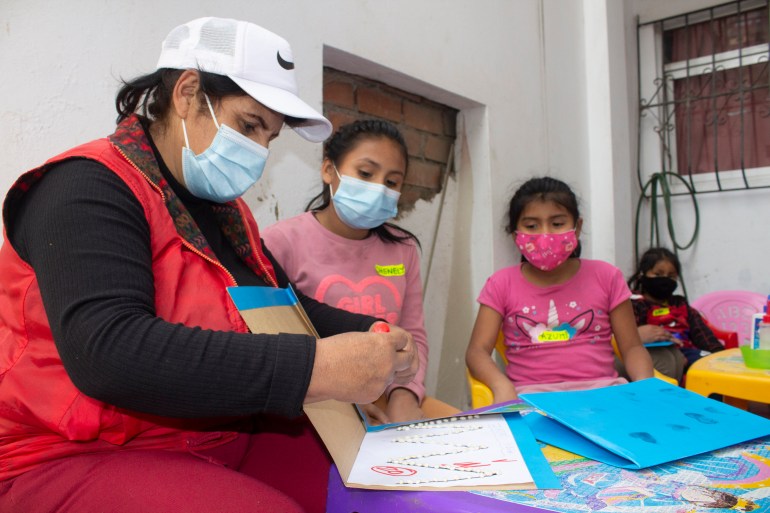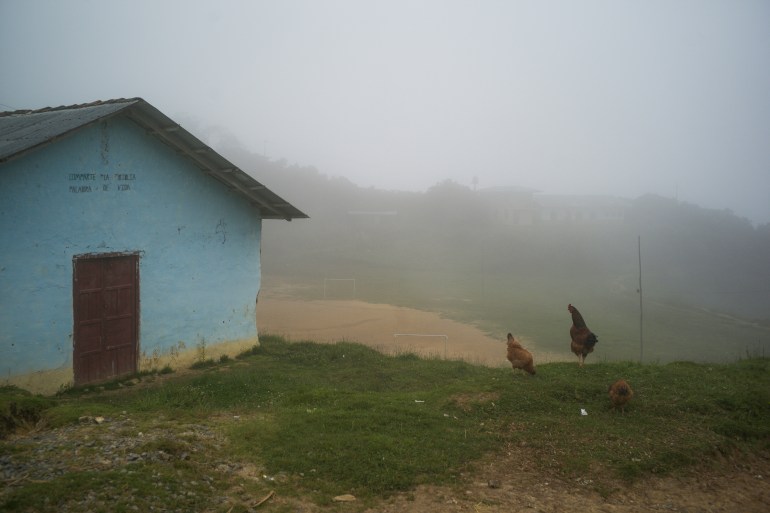As Peru opens from pandemic, nearly all schools remain closed
Amid high rates of poverty, lack of in-person learning is having a devastating effect on families.

Lima, Peru – For Maria Molina, a single mother struggling to take care of two granddaughters, the idea that Peru’s state schools have been providing online learning during the pandemic feels like a bad joke.
She can barely afford her 10-gigabyte monthly mobile phone plan, which costs 75 sols ($19). It is the only phone the family has and must be shared by her 17-year-old daughter, who is studying nursing, and two granddaughters, Azumi, eight, and Chenely, 11.
Keep reading
list of 3 itemsPeru’s President Castillo swears in new prime minister
The Shining Path controversies that spurred Peru’s gov’t shake-up
“My daughter is the priority. She has to be,” Molina, 56, who works as a freelance makeup saleswoman, says. “Azumi and Chenely haven’t gone to school, even online, since the pandemic started.”
“The school keeps saying they will give us tablets but they never do. Sometimes the plan runs out with a week to go. Then that’s it for the rest of the month. No one can study anything.”
Molina adds that she is able to make ends meet only because one of her sons, 22, who still lives with her in their single-room shack, shares his earnings as a day labourer.
“He’s a good son. Thank God,” Molina says. “Without him, we wouldn’t even eat.”

Here, in this gritty neighbourhood of Maria del Triunfo, on Lima’s steep, dusty eastern margins, largely populated by migrants from the Andes and the Amazon, this story is all too familiar.
Peru’s schools shut down completely as the coronavirus pandemic exploded globally in mid-March 2020, just two weeks after the southern school year started.
Although a small number of remote, rural schools have had in-person classes since then, and a handful of private schools and well-resourced public schools have this month begun receiving pupils for two half-days a week, some 99 percent of Peru’s schools have throughout the pandemic been either closed completely or offered only online classes, which many children, like Azumi and Chenely, could not access.
That is despite Peru reopening shopping malls and casinos with occupancy restrictions last year.
In a country where nearly one in five people live below the official poverty rate — defined as earning less than 338 sols ($85) a month — the effect on millions of children has been devastating.
Although there is a dearth of good international statistics, Peru is one of the last in Latin America to still keep most of its schools shut. Even crisis-ridden Venezuela has now resumed in-person classes, while globally 80 percent of countries have returned to normal schooling.
School reopenings in doubt
In Maria del Triunfo, already plagued by a host of social problems, including alcoholism and domestic violence, a generation of children has largely been left to themselves, roaming the streets while their parents work, missing out on two formative years of their education.
The problem has been both caused and exacerbated by Peru’s disastrous handling of the pandemic, recording the world’s highest per capita COVID mortality. It has laid bare decades of underfunding in the health and education sectors while also sickening and killing many parents and other breadwinners and caregivers.
Yet, now, even with the vaccination rate rapidly rising and a lull in infections, the long-awaited reopening of the Andean nation’s schools is once again in doubt. Critics say it is a victim of political infighting and an unscientific, punitive approach that has even meant many of Peru’s outdoor playgrounds are still being cordoned off by local governments.
This week, Prime Minister Mirtha Vasquez announced that the goal was to have schools reopen in March 2023. That could require significant investment in currently inadequate infrastructure, with Vasquez warning that reopening may have to be pushed back to July.
That worries Cesar Ugarte, an epidemiologist at the Cayetano Heredia University, Peru’s top medical school. “It’s very concerning to hear the prime minister even mentioning July. The Peruvian state moves so slowly that we could end up losing a third year. One way or another, we have to start in March.”
But the main teachers’ union in Peru, SUTEP, is resisting those plans. It is insisting on a list of conditions, including that all teachers be fully vaccinated.

SUTEP leader Lucio Castro told Al Jazeera that 54 percent of state schools have no “basic services”, including sewerage and electricity. That rate rises to 79 percent in rural areas. Meanwhile, just 60 percent of teachers have been immunised.
“We are just asking for basic infrastructure, not perfection,” he said. “Teachers are more interested than anyone in returning to school. We understand that those most harmed by this are the students.”
Ugarte acknowledges that SUTEP’s demand that teachers be prioritised in the vaccination queue may have made sense once, but is now irrelevant. He also believes providing sanitiser in schools, rather than plumbing, should be the short-term objective.
Peru has now fully vaccinated more than 15 million people, most with Pfizer and Sinopharm shots. In Lima, where roughly one-third of the population of 32 million lives, and other big cities, the government is now vaccinating teenagers.
“There’s no excuse now. If you’re over 18, you had the chance to get the shots,” says Ugarte. “At some point, we may have to start doing with teachers what they’re doing in other countries with medical personnel. If you’re not vaccinated, goodbye. Otherwise, you’re putting our children at risk.”
‘There are ways to recover’
SUTEP’s anger with the government has a long and complicated history. Pedro Castillo, Peru’s new left-wing president, was a rural school teacher and member of that union — until he led a wildcat strike in 2017, opposing reforms in Peru’s underperforming schools, including requiring teachers to pass tests, and formed a new group.
One of the first things that he did, on taking office, was to officially recognise FENATEP, his breakaway union. Meanwhile, the new education minister, Carlos Gallardo, a Castillo ally, has also been suggesting that schools may not be required to reopen in March. His ministry did not respond to Al Jazeera’s request for comment.
Issues at stake include overall school spending, especially raising rock-bottom teaching salaries. The current government is proposing 4 percent of gross domestic product (GDP), far below Castillo’s campaign promise of 10 percent, which won him the qualified backing of SUTEP.
Nevertheless, Ricardo Cuenca, who was education minister in the previous government, insists a solution can be found. “The message that everything is lost is not a good one for children. There are ways to recover. And experiences in other countries, with the resumption of schooling, have not all been great.”
“But there shouldn’t be any more delays. We came up with the current coronavirus protocol at a time when there was community transmission. The circumstances have changed.”
Back in Maria del Triunfo, Azumi and Chenely may actually be among the lucky ones. They are at least getting two hours of classes a week provided by a local primary school teacher, Norma Huamani on her own initiative.
She teaches about 15 kids at her home on Tuesday and Thursday afternoons, after finishing her Zoom sessions with pupils at the local private school where she works.
“Teachers in the state schools are just content to keep drawing their salaries,” Huamani, 59, says.
“In the private schools, many teachers have had their salaries halved. We now have kids, who are eight or nine, who can’t read and are just hanging out in the street. This is the least I could do.”